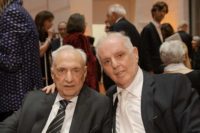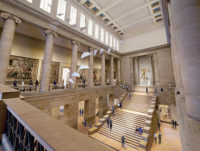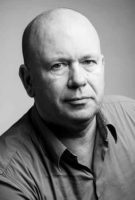Interview with Frank Gehry on a Milestone Birthday
The architect turns 90.

Photo © Alexandra Cabri

The birthday concert venue in Berlin, Pierre Boulez Saal
Photo © Roland Halbe

Arts Resource Building, Luma Arles, Parc des Ateliers, France, last November
Photo © Hervé Hôte



Architects & Firms
When Frank Gehry first made a splash decades ago, his work was inspired by the contemporary artists working in Los Angeles, where he lives. That was especially evident in his own house in Santa Monica (1978), a 1920 Dutch Colonial that he famously recreated as an assemblage of humdrum materials like chain link and plywood, juxtaposed in entirely unexpected ways. Later, as his architecture evolved, he began to work in the world of music, designing what is arguably his greatest building—alongside the Guggenheim Bilbao—the Walt Disney Concert Hall (2003) in L.A., as well as the New World Center in Miami Beach and the Pierre Boulez Saal in Berlin, where he planned to celebrate his 90th birthday at the end of last month. He spoke to RECORD’s editor in chief, Cathleen McGuigan, about that occasion.
You’re marking your birthday with music—that’s become a big part of your work and your life.
Well, it’s interesting, because I’m not a musician—I can’t read music. But over the years, I’ve gotten involved with the culture of music because I love doing concert halls, and very much enjoy the musical friendships that have come from that. I like spending time with these musicians and hearing their struggles. They’re artists!
At the start of your career, you were particularly inspired by visual artists.
I still am. I haven’t abandoned visual artists at all. It’s just that there are these intriguing opportunities with concert halls: they are about creating spaces where the art, the space, and the people all come together, in one place at one time, all within an hour or two. You can see the relationships between the musicians and the people when they’re in the hall, when they’re experiencing the music, and how the musicians feel when they get positive feelings in the room. It’s empowering.
So the Pierre Boulez concert hall in Berlin, the venue for your birthday party, came out of your friendship with the conductor Daniel Barenboim.
Yeah, that was special because of the youth orchestra he put together with [the late scholar] Edward Said, focusing on music as a way of communication between the disparate cultures of Israel, Palestine, Lebanon, Syria, Egypt, and so forth. These young musicians from different backgrounds have the ability to not just play together but to eat together and spend time together.
So how did your birthday concert come about? Did Daniel Barenboim ask you if you wanted any particular pieces to be played?
No, he didn’t offer me that. He just called and said, “Frank, your birthday’s coming up. We’d love to dedicate this concert to you. Could you come?” I said yes, and that was it.
Longevity seems to be a bonus for very successful architects, like the other Frank, Lloyd Wright. You’re 90, you’re in great shape, and you haven’t even slowed down. What’s your secret?
Well, the only secret is, Philip Johnson [who lived till 98] told me to keep working. And one of my best friends, who also lived into his late 90s, forbade me from retiring.
OK, since you’re not retiring, let’s talk about what you’re working on. You’re building two condo towers—as high as 91 stories—in Toronto. And you’re designing more concert venues, for the expansion of the Colburn School of Music in L.A., and there’s talk of a Gehry concert hall in Wimbledon, outside London. And what about the art center in Arles, in the South of France?
Yes. Arles has involved a special relationship with [Swiss patron] Maja Hoffman. She’s a very hands-on client, and we had the luxury of being able to try things along the way.
What kinds of things?
Well, I said I would like to paint with light, but here, specifically, I got into the texture of the wall. On the exterior, we made these blocks out of stainless steel and set them slightly off each other. They cast a light, and the facade is like a painting. At one point, you actually get the light that’s similar to what Van Gogh got in Starry Night. He was painting in the same light.
What do you think are the biggest misconceptions about your work?
When I started using chain link, I was only interested in it because I knew that everybody hated it, and I was trying to get a handle on denialism. We live in a city, and people complain about it. I thought if I could work with it and make it more acceptable, I could overcome that chain link hatred. I was just curious where the line of denialism was.
I was playing with things that were normal to culture, like corrugated metal—things like that were being done in various ways in the community that were not liked. And if you could use them—and certainly Robert Rauschenberg was an inspiration, using things like that, and so were other artists, like Gordon Matta Clark. So it was something to explore. Those works have become high art. Look at Basquiat, who used to hang around our office in Venice before he was well known
And art continued to inspire your architecture.
Right, the artists were doing it—the architects weren’t. The architecture world at that time hit a dead end with Modernism, and then along came Postmodernism. I think that was triggered by Arthur Drexler’s Beaux-Arts show at MoMA [in 1975].
That opened it up for everybody. And it was seductive—I loved it. So that’s when I thought, well, the buildings of the past are based on Greek temples, which are anthropomorphic. I said, “If you have to go back then, why don’t you go back 300 million years, before man could fish?” And then I realized I was looking for ways to express motion. Our time was different than the time of the Beaux-Arts because of planes, trains, cars—things were moving. So I thought that maybe there was something in the expression of forms that were moving. And fish forms are for the most part very architectural. I went off on that for a while. I still make fish lamps.
And you still make buildings that, you could argue, have sort of shiny scales on them.
You could sum up my career as something pretty fishy.
Is there a building type you haven’t done yet that you would really like to do?
I like doing social housing. We’re trying to do that as part of the L.A. River project we’ve been working on with a couple of developers. We also want to design veterans housing. And I’ve always wanted to do elementary schools, but in all the years I’ve been practicing, the fees are just terrible. Today, we could do it as philanthropy.
You focused your last studio at Yale on rethinking prisons. You said at the time you learned as much from the studio as anybody.
I think we just tapped the surface of it. We were asked by a group related to the Soros Open Society Foundations. They were interested in recividism and prison culture. We took the studio to tour Scandanavian prisons, to see the other side of that coin—how they treat people in a humanistic environment and the rewards of returning these people back to being human beings again. I don’t know if we’ll ever accomplish that here, but there is an example we need to follow.
Prison design is a big topic for us to get involved in, but it can’t be treated as designing with the current programs as a given. You need to become part of a group that’s willing to make changes, to figure out ways to humanize the prison, to engage people through design.
There are architecture firms that are trying to improve what already exists But it’s not a real rethink the way the Scandinavians have done. This prison question is really important, but, tell us, aside from social ideas, what do you think is the most important issue facing architects today?
I came into architecture thinking it was an art. That’s why I tended to get involved in the artist culture—I hung out with artists in those days. I think architecture has been chronically morphed into engineering and social issues and involvement—and that’s a good thing. But I think young people coming in want to choose where they want to play, where they’re challenged. We’re desperate for the art of architecture in our culture. It would be nice if it would be recognized as an aspiration and not diminished by a stupid word like starchitect.
So what advice would you give to a young architect about his or her career?
I think an individual has to be his or her self. Everybody’s different. I’m not saying you will be Frank Lloyd Wright or Mies van der Rohe, but at least you will be yourself, and chances are that will be rewarded. It will be exciting, because it will be original thinking. It means it’s not necessary to look like someone else or follow a philosophy or discourse, like they do in the university, which gets all tied up in verbal constructs that are not even translatable. My idea is, if you can’t talk the talk, at least you can draw.
Thank you, Frank, and happy birthday.





